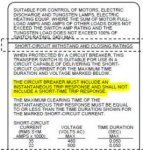I'm trying to get a better understanding of an ATS 30-cycle rating. Does this rating only apply to ATS's that have integral power circuit breakers to them or does this rating also apply contactor based or molded case breaker based ATS?
I'm looking at a situation where an ATS if fed from an upstream power circuit breaker that does not have an Instantaneous setting and only has long time and short time settings. The ATS is a 400A ATS with molded case breakers. Should this ATS have a 30-cycle rating in order to be adequately protected by upstream breaker or do only certain types of ATS (with integral power breakers) have a 30-cycle rating.
I know ATS have "specific breaker", and "any breaker" ratings and I have also seen "30 cycle rating" but now sure how this is applied.
I'm looking at a situation where an ATS if fed from an upstream power circuit breaker that does not have an Instantaneous setting and only has long time and short time settings. The ATS is a 400A ATS with molded case breakers. Should this ATS have a 30-cycle rating in order to be adequately protected by upstream breaker or do only certain types of ATS (with integral power breakers) have a 30-cycle rating.
I know ATS have "specific breaker", and "any breaker" ratings and I have also seen "30 cycle rating" but now sure how this is applied.

